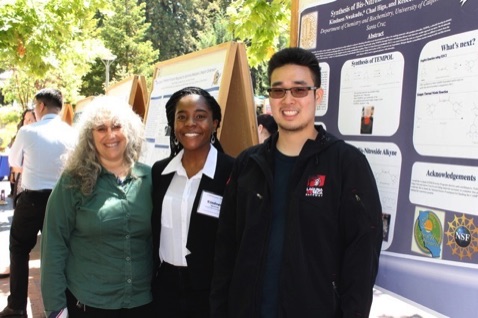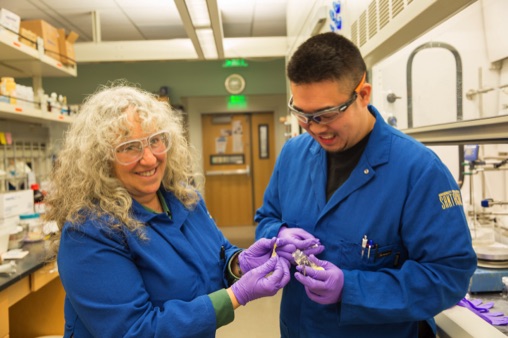Dr. Chad Higa
Ph.D. 2018: “ Non-Migratory Internal Plasticization of Poly(Vinyl Chloride) via Pendant Triazoles Bearling Alkyl or Polyether Esters"
Bachelors of Science: University of Hawaii, Hilo
Publications with the Braslau Group:
1. Magee, C.; Earla, A.; Petraitis, J.; Higa, C.; Braslau, R.; Zetterlund, P. B.; Aldabbagh, F. "Synthesis of
fluorinated alkoxyamines and alkoxyamine-initiated nitroxide-mediated precipitation polymerizations
of styrene in supercritical carbon dioxide" Polymer Chemistry 2014, 5 (19), 5725-5733.
2. Chad M. Higa, Andy T. Tek, Rudy J. Wojtecki, Rebecca Braslau "Non-Migratory Internal Plasticization of Poly(Vinyl Chloride) via Pendant Triazoles Bearing Alkyl or Polyether Esters" submitted.





Thesis Abstract:
Poly(vinyl chloride) (PVC) is one of the most utilized thermoplastics on Earth. However, PVC by itself is brittle and not readily processable. This material reached the success of its worldwide demand because of phthalates, a cost-effective additive (emollient) that imparts flexibility and resistivity towards weathering, temperature extremes and electrical conductivity. The use of phthalates as plastic emollients is widespread, representing approximately three quarters of all plasticizers globally, with applications ranging from industrial to consumer products. The pervasive utilization of low molecular weight blended phthalates as emollients inevitably leads to leaching, contamination and exposure. Phthalates and their metabolites have displayed negative effects on various organs and act as potent endocrine disrupting chemicals that cause deleterious pre- and postnatal developmental
effects, notably in males. Bans of phthalates by the European Union and the United States in children's articles have spurred the development of less toxic PVC plasticizer alternatives.
Branched and linear non-migratory internal plasticizers attached to PVC by a pendant triazole linkage were synthesized. Copper-free azide-alkyne thermal cycloaddition was employed to covalently bind triazole-based phthalate mimics to poly(vinyl chloride) (PVC). To systematically investigate the effect of plasticizer structure on glass transition temperature, several architectural motifs were explored. Free volume theory was considered when designing many of these internal plasticizers: hexyl-tethers were utilized to generate additional space between the triazole-phthalate mimic and the polymer backbone. Miscibility of these triazole-plasticizers in PVC is important: variation of the ester moieties on the triazole possessing alkyl and/or poly(ethylene1 oxide) (PEO) chains produced a wide range of glass transition temperatures (Tg): from anti-plasticizing 96 °C, to highly efficient plasticized materials exhibiting Tg values as low as -42 °C.
Triazole methyl esters directly appended to PVC displays an inherent anti- plasticization effect originating from the aromatic ring, which diminishes with increasing molecular weight and branching of the alkyl ester chains. Introduction of a flexible hexyl tether to the secondary triazole group acts as additional molecular weight and branching, further lowering Tg values. Attachment of two hexyl tethered secondary triazoles follows this trend by enforcing another branch point and increasing molecular weight. Utilization of PEO esters in all architectural types significantly enhances Tg depressions, with longer PEO chains exhibiting remarkable results. Single PEO triazole esters readily prepared from propiolic esters using low-cost, commercially available materials combine excellent plasticization with straightforward synthesis, making these non-migratory internal plasticizers extremely attractive for industrial applications.
An alternative strategy to post-polymerization direct modification of PVC to obtain internally plasticized materials involves the copolymerization of vinyl chloride monomer (VCM) with a monomer functionalized with a triazole-phthalate mimic. Electron-rich vinyl acetate monomers with an appended triazole-plasticizer were synthesized for this purpose. Copolymerizations with the vinyl acetate triazole monomers and VCM were largely unsuccessful. It was envisaged that an acrylate derivative should remedy the low reactivity of these vinyl acetate monomers. An acrylate incorporating a hexyl-tethered triazole-phthalate mimic served two purposes: 1) generate space between the triazole and polymerizing vinyl group to prevent monomer deactivation and, 2) enhance the plasticization efficiency of the triazole.

